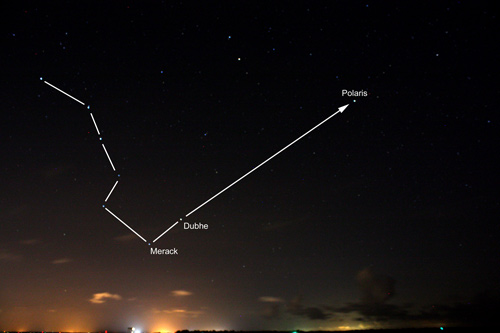Announcement: My online Land Navigation course includes four hours of video instruction, and two downloadable PDF books, all for about the same price as a typical paperback book. Get my Land Navigation course here.
The Big Dipper
The Big Dipper, a seven-star grouping, is probably the constellation best known for use in finding Polaris. Shaped like a giant water dipper, complete with a long, curved handle, the Dipper circles Polaris in the sky's northern region.

To find Polaris: Draw an imaginary line from
Merak through Dubhe. Continue the line straight out--five times the distance from Merak to Dubhe.
Where the Dipper Sets
At latitude 41 North and above, the Dipper never sets, but is seen all night long continuously circling Polaris in a counterclockwise fashion. Farther south, however, the Dipper disappears at least for a time under the horizon in its path around the sky's northern pole.
Note
A star that never sets is said to be "circumpolar."
Merak and Dubhe Point the Way
To find Polaris from the Dipper, look for the two stars located at the end of the Dipper's cup, farthest from the handle. The star at the bottom of the cup is named Merak (MAIR-ack), while the star at the cup's top is called Dubhe (doob-AY). These are the "pointer" stars, so named because an imaginary line between points to Polaris.
To see this for yourself, draw a line in your mind's eye from Merak through Dubhe. Now, extend this imaginary line out five times the distance from Merak to Dubhe, and, assuming the sky is clear, you'll find Polaris.
If the north sky is obscured from view by clouds, trees, or anything else, you can still find north. Just extend the proper length line (see above) from Merak through Dubhe. Where that line ends is approximately where you'd find Polaris if you could see it. From that spot in the sky, imagine a line extending down to the horizon. Where that line touches the horizon is true north.
Return from The Big Dipper to Celestial Navigation
Return from The Big Dipper to Home

